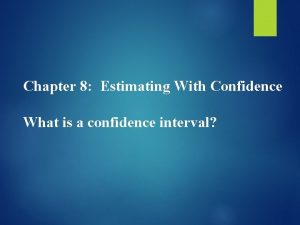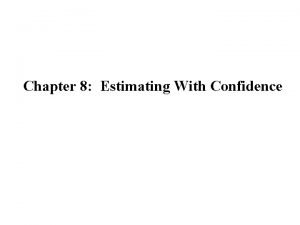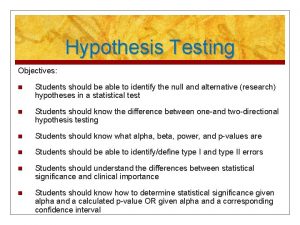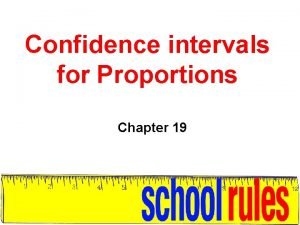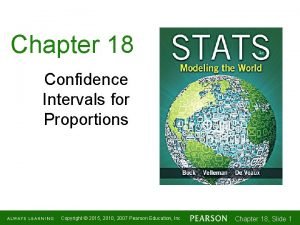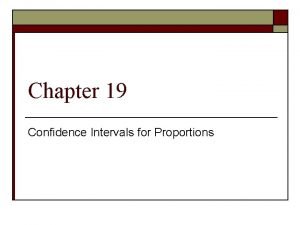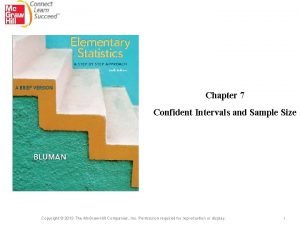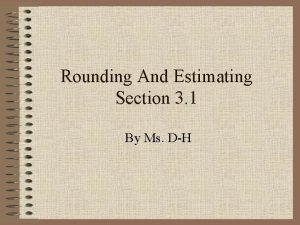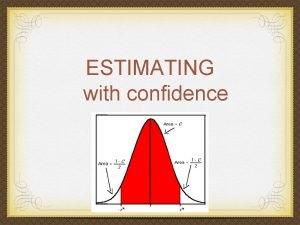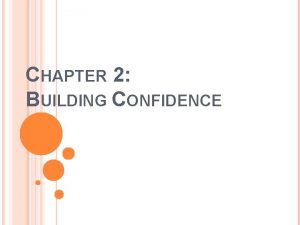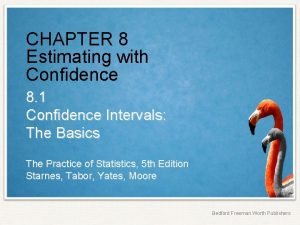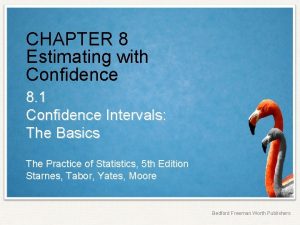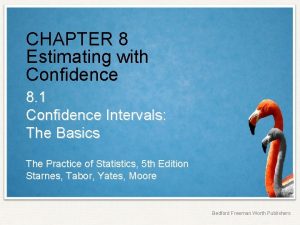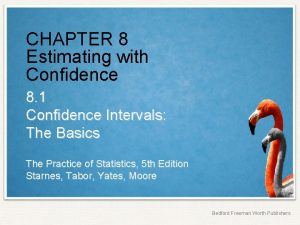CHAPTER 8 Estimating with Confidence 8 2 Estimating











- Slides: 11

CHAPTER 8 Estimating with Confidence 8. 2 Estimating a Population Proportion The Practice of Statistics, 5 th Edition Starnes, Tabor, Yates, Moore Bedford Freeman Worth Publishers

Estimating a Population Proportion Learning Objectives After this section, you should be able to: ü STATE and CHECK the Random, 10%, and Large Counts conditions for constructing a confidence interval for a population proportion. ü DETERMINE critical values for calculating a C % confidence interval for a population proportion using a table or technology. ü CONSTRUCT and INTERPRET a confidence interval for a population proportion. ü DETERMINE the sample size required to obtain a C % confidence interval for a population proportion with a specified margin of error. The Practice of Statistics, 5 th Edition 2

One-Sample z Interval for a Population Proportion Once we find the critical value z*, our confidence interval for the population proportion p is One-Sample z Interval for a Population Proportion When the conditions are met, a C% confidence interval for the unknown proportion p is where z* is the critical value for the standard Normal curve with C% of its area between −z* and z*. The Practice of Statistics, 5 th Edition 3

One-Sample z Interval for a Population Proportion Suppose you took an SRS of beads from the container and got 107 red beads and 144 white beads. Calculate and interpret a 90% confidence interval for the proportion of red beads in the container. Your teacher claims 50% of the beads are red. Use your interval to comment on this claim. z . 03 . 04 . 05 – 1. 7 . 0418 . 0409 . 0401 – 1. 6 . 0516 . 0505 . 0495 – 1. 5 . 0630 . 0618 . 0606 ü Sample proportion = 107/251 = 0. 426 ü We checked the conditions earlier. ü For a 90% confidence level, z* = 1. 645 We are 90% confident that the interval from 0. 375 to 0. 477 captures the true proportion of red beads in the container. Since this interval gives a range of plausible values for p and since 0. 5 is not contained in the interval, we have reason to doubt the claim. The Practice of Statistics, 5 th Edition 4

The Four Step Process We can use the familiar four-step process whenever a problem asks us to construct and interpret a confidence interval. Confidence Intervals: A Four-Step Process State: What parameter do you want to estimate, and at what confidence level? Plan: Identify the appropriate inference method. Check conditions. Do: If the conditions are met, perform calculations. Conclude: Interpret your interval in the context of the problem. The Practice of Statistics, 5 th Edition 5

Choosing the Sample Size In planning a study, we may want to choose a sample size that allows us to estimate a population proportion within a given margin of error. The margin of error (ME) in the confidence interval for p is z* is the standard Normal critical value for the level of confidence we want. The Practice of Statistics, 5 th Edition 6

Choosing the Sample Size In planning a study, we may want to choose a sample size that allows us to estimate a population proportion within a given margin of error. Calculating a Confidence Interval To determine the sample size n that will yield a level C confidence interval for a population proportion p with a maximum margin of error ME, solve the following inequality for n: The Practice of Statistics, 5 th Edition 7

Example: Determining sample size A company has received complaints about its customer service. The managers intend to hire a consultant to carry out a survey of customers. Before contacting the consultant, the company president wants some idea of the sample size that she will be required to pay for. One critical question is the degree of satisfaction with the company’s customer service, measured on a five-point scale. The president wants to estimate the proportion p of customers who are satisfied (that is, who choose either “satisfied” or “very satisfied, ” the two highest levels on the five-point scale). She decides that she wants the estimate to be within 3% (0. 03) at a 95% confidence level. How large a sample is needed? The Practice of Statistics, 5 th Edition 8

Example: Determining sample size Problem: Determine the sample size needed to estimate p within 0. 03 with 95% confidence. ü The critical value for 95% confidence is z* = 1. 96. ü We have no idea about the true proportion p of satisfied customers, so we decide to use p-hat = 0. 5 as our guess. ü Because the company president wants a margin of error of no more than 0. 03, we need to solve the equation: ü margin of error < 0. 03 The Practice of Statistics, 5 th Edition 9

Example: Determining sample size Because the company president wants a margin of error of no more than 0. 03, we need to solve the equation Multiply both sides by square root n and divide both sides by 0. 03. Square both sides. We round up to 1068 respondents to ensure that the margin of error is no more than 3%. The Practice of Statistics, 5 th Edition 10

Estimating a Population Proportion Section Summary In this section, we learned how to… ü STATE and CHECK the Random, 10%, and Large Counts conditions for constructing a confidence interval for a population proportion. ü DETERMINE critical values for calculating a C % confidence interval for a population proportion using a table or technology. ü CONSTRUCT and INTERPRET a confidence interval for a population proportion. ü DETERMINE the sample size required to obtain a C % confidence interval for a population proportion with a specified margin of error. The Practice of Statistics, 5 th Edition 11
 Chapter 8 estimating with confidence
Chapter 8 estimating with confidence Suppose your class is investigating the weights of snickers
Suppose your class is investigating the weights of snickers Chapter 8 estimating with confidence
Chapter 8 estimating with confidence Confidence interval vs confidence level
Confidence interval vs confidence level Confidence interval vs confidence level
Confidence interval vs confidence level Critical value for 90 confidence interval
Critical value for 90 confidence interval Chapter 18 confidence intervals for proportions
Chapter 18 confidence intervals for proportions Chapter 19 confidence intervals for proportions
Chapter 19 confidence intervals for proportions When is stage fright most evident
When is stage fright most evident Chapter 7 confidence intervals and sample size
Chapter 7 confidence intervals and sample size Types of information system
Types of information system Rounding and estimating
Rounding and estimating
